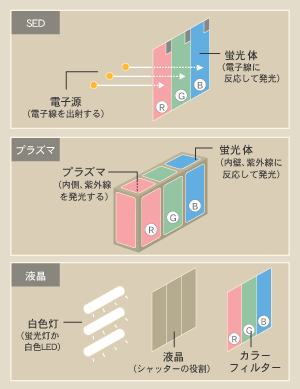
毎日新聞 2006/3/1
第3の薄型テレビSED 発売 いつになる・・
液晶、プラズマ値下がり
低コスト量産態勢整わず
液晶、プラズマに続く「第3の薄型テレビ」の発売時期が大幅に遅れている。「SED」(表面電界ディスプレー)と呼ばれ、キャノンと東芝が共同開発したもので、高画質と低消費電力を売り物に、05年中の発売を目指していた。しかし、大幅に遅れ、今では年内の発売も危ぶまれている。液晶、プラズマの値下がりに対抗する必要が生じ、「低コストでの量産技術の確立に時間がかかっている」(キャノンの御手洗冨士夫社長)のが遅れの最大の原因だ。
しかし、重要技術の特許出願をせず、技術を社外に一切出さない方針を徹底したため、主要部品などを外注できず、開発スピードが思うように上がらなかった。その間、ライバルの液晶、プラズマは価格が急落。このため、当初の想定より低コストで量産できる技術開発が必要になり、昨年4月、両社は発売時期を06年春に延期した。
| SED 新方式のディスプレー。 ブラウン管と同じ発光原理で、電子を発光面に塗布した蛍光体にぶつける。画質はブラウン管並みに明るく、高コントラストで、原理上は液晶、プラズマより低消費電力とされる。ブラウン管は一つの電子銃が出す電子を曲げるために奥行きが厚くなる、SEDは一つの蛍光体ごとに一つの電子をぶつけるため薄型にできる。 |
薄型大画面テレビ界に「大型新人」誕生か、SEDが来年末にも商品化へ
。 
SEDはSurface-conduction Electron-emitter Displayの略。薄型テレビ市場の大半を占める液晶やプラズマとは、仕組みが大きく異なるパネルだ。液晶は、白い光をカラーフィルターに通して色を表現。プラズマは、気体を光らせ、その光に反応する蛍光体で色を出す。対して、SEDはブラウン管に近い。ブラウン管と同様、RGB(赤緑青)の蛍光体に電子線を当てて画像を表示するのだ。
ブラウン管の場合、電子線はRGBそれぞれに1本。計3本の電子線が画面上を連続的に走査する。蛍光体はシャドウマスクやアパチャーグリルと呼ばれるワイヤーで区切られ、独立した画素として見える。これに対して、SEDは電子線を発する電子源を「画素の数×3色分」用意。これにより、ブラウン管に不可欠な偏向ヨークを不要にした。偏向ヨークとは、画面の隅々まで走査するために、電子線を曲げる部品。偏向ヨークをなくしたことで、SEDは薄型化を実現し、消費電力も削減した。SEDでは、画素を区切るワイヤーも不要。これで、ワイヤーに電子線が当たることによる無駄な発熱も防げる。まさに、ブラウン管から厚みと熱を取り去ったものがSEDなのだ。
2007年1月12日 キヤノン/東芝
Nano release
キヤノンによるSED株式会社の完全子会社化について
キヤノン株式会社(以下キヤノン)と株式会社東芝(以下東芝)は、両社で設立したSED株式会社に関して、2007年1月29日をもって、キヤノンが東芝保有の全株を買い取り、完全子会社とすることを決定いたしました。
今回の決定は、キヤノンに対する“SED”の技術に関連する米国訴訟の長期化が予想されることから、SEDテレビ事業の早期立ち上げに向けて両社で協議した結果、SEDパネルの事業をキヤノン単独で行うことにしたものです。
asahi 2006/12/30
キヤノンを訴えたのは、関連技術のライセンス契約を同社と結ぶ米ナノテク会社「ナノ・プロプライアタリー」(NP、米ナスダック市場上場)。SED社がキヤノンの子会社かどうかを巡り、05年4月に米国で提訴。和解交渉が難航しており、キヤノンは新工場をいったん断念することにした。訴訟が解決すれば、改めて量産を検討する可能性は残っている。
キヤノンは、SED社株を東芝より1株多く持つため子会社とみなし、契約に基づいてSED社にもライセンスを移せると主張。これに対し、NPは「SED社の意思決定には東芝の同意が必要で、実質的には子会社ではない」と反論している。キヤノンは「子会社」との判決を求める動議を米連邦地裁に出したが、先月棄却された。
NANO-PROPRIETARY, INC. COMMENTS ON CANON'S PRESS RELEASE REGARDING SED, INC. OWNERSHIP
Nano-Proprietary, Inc., today announced that it is pleased Canon, Inc. and Toshiba Corporation have decided to continue to move forward with their SED TV.
"Restructuring of Canon's ownership position does not resolve the pending litigation which goes to trial in a few weeks," said Tom Bijou, Chief Executive Officer of Nano-Proprietary, Inc. "We have terminated Canon's license as a result of breach of contract. Moreover, our complaint against Canon includes other counts, including fraud unrelated to the ownership of SED. We are, however, willing to enter into a new license agreement with Canon on reasonable terms."
ABOUT NANO-PROPRIETARY, INC.
Nano-Proprietary, Inc. is a holding company consisting of two wholly-owned operating subsidiaries. Applied Nanotech Inc. is a premier research and commercialization organization dedicated to developing applications for nanotechnology with an extremely strong positions in the fields of electron emission applications from carbon film/nanotubes, sensors, functionalized nanomaterials, and nanoelectronics. Electronic Billboard Technology, Inc. (EBT) possesses technology related to electronic digitized sign technology. The Companies have over 200 patents or patents pending. Nano-Proprietary's business model is to license its technology to partners that will manufacture and distribute products using the technology. Nano-Proprietary's website is www.nano-proprietary.com .
NANO-PROPRIETARY FILES DECLARATORY JUDGMENT ACTION AGAINST CANON
Nano-Proprietary, Inc. announced today that it has filed suit against Canon, Inc. in U.S. District Court for the Western District of Texas, Austin Division. Nano-Proprietary is seeking a declaratory judgment that new SED color television products, scheduled to be manufactured by Canon and/or Toshiba beginning in August 2005, are not covered under a 1999 patent license agreement between Canon and Nano-Proprietary. Nano-Proprietary alleges that Canon is improperly using Nano-Proprietary’s patented technology to produce surface conductor electron emitter display screens (SED) for a new generation of flat screen color televisions.
Nano-Proprietary also asserts that a joint venture formed by Canon and Toshiba Corporation to produce the SED display screens, SED, Inc., is not a licensed subsidiary under the 1999 agreement and that Canon is improperly transferring its license rights under Nano-Proprietary's patents to the joint venture and Toshiba. Nano-Proprietary also alleges that Canon’s representation to the industry that it is licensed violates federal false advertising statutes.
In January 2005, Canon announced the imminent launch of SED flat screen televisions at the Consumer Electronics Show in Las Vegas, Nevada. According to the suit, Nano-Proprietary asserts that the new SED televisions fall squarely within the definition of excluded products under the 1999 agreement. Nano-Proprietary's suit asks the federal court to adjudicate the parties rights' under the 1999 license and to stop Canon from representing that they have a license and that others in the industry can join them under the license.
“We have a very strong and pervasive patent portfolio that applies to several multibillion dollar industries, of which this is one,” said Marc Eller, Chairman and CEO of Nano-Proprietary. “We will aggressively protect our rights against any and all violations of our intellectual property,” continued Eller.
Nano-Proprietary is represented by Collier Shannon Scott, PLLC, a Washington D.C.-based firm serving domestic and international clients through combined expertise in regulation, litigation, and government relations. Collier Shannon Scott has successfully represented U.S. companies and industries in many unfair trade practice cases, including cases involving Japanese and Chinese televisions and flat panel displays from Japan.
| May 18, 2006
NANO-PROPRIETARY,
INC. AND MITSUI & CO. LTD ANNOUNCE STRATEGIC
ALLIANCE TO COMMERCIALIZE CARBON
NANOTUBE TECHNOLOGY |
日本経済新聞 2007/5/26
キャノン SEDテレビ
発売再延期 米社と特許訴訟長期化
事業化一段と厳しく
競合するブラズマテレビと液晶テレビの価格下落が進む一方、SEDの低コスト化技術の確立が遅れたため、発売をいったん今年末に延期。そのうえで量産化にメドをつけ、東芝の姫路工場(兵庫県太子町)で、東芝、キャノンが計2千億円を投じて生産を始める予定だったが、続いて特許問題が壁になった。
今月、米連邦地裁が、キャノンと東芝の共同出資会社へのSED技術のライセンス移管は契約違反であり、違反した時点で契約が終了しているとの判決を下した。キャノンは控訴したが、和解など解決のメドはまだ立っていない。
| キャノンのSEDへの取り組み | ||||||||||||
|
巨額投資、コスト減競う 薄型テレビ開発 焦点は有機ELに
薄型テレビ市場で生き残るための条件は急速に巌しさを増している。現在主流のブラズマ、液晶のメーカーは巨額投資によるコスト削減に突き進む。次の世代の目玉としては有機ELが台頭。キャノンがSEDの事業化に時間をかけるほど状況は苦しくなる。
Nano-Proprietary, Inc. Announces Verdict in Canon Litigation
Nano-Proprietary, Inc., today announced that the jury has reached a verdict in its litigation against Canon, Inc. In its verdict, the jury decided that Nano-Proprietary was due no additional damages beyond those already received, which includes the right to keep the $5.5 million that it originally received and termination of the original license agreement.
While we are disappointed by the jury's verdict, we need to keep in mind that we already had the most important victory in the case when the Court validated our termination of Canon's license as a result of their material breach of the contract, said Tom Bijou, Chief Executive officer of Nano-Proprietary, Inc. We were also pleased that during the trial, Canon confirmed its plans to move forward with its SED TV and continue to believe that the advent of field emission display televisions will be a signal event for Nano-Proprietary. We made a significant gesture to Canon during the course of the trial that we hope will provide a framework of cooperation and negotiation for the future. Nothing about today's verdict changes the fact that we have significant intellectual property that we believe will have to be licensed by anybody, including Canon, that wishes to sell televisions based on electron emissions in the broad geographical areas of the world where our IP is in effect. The vast majority of our revenue forecast for 2007 has little to do with televisions. Our growth in the materials and sensor business continues to be one of the drivers of our future."